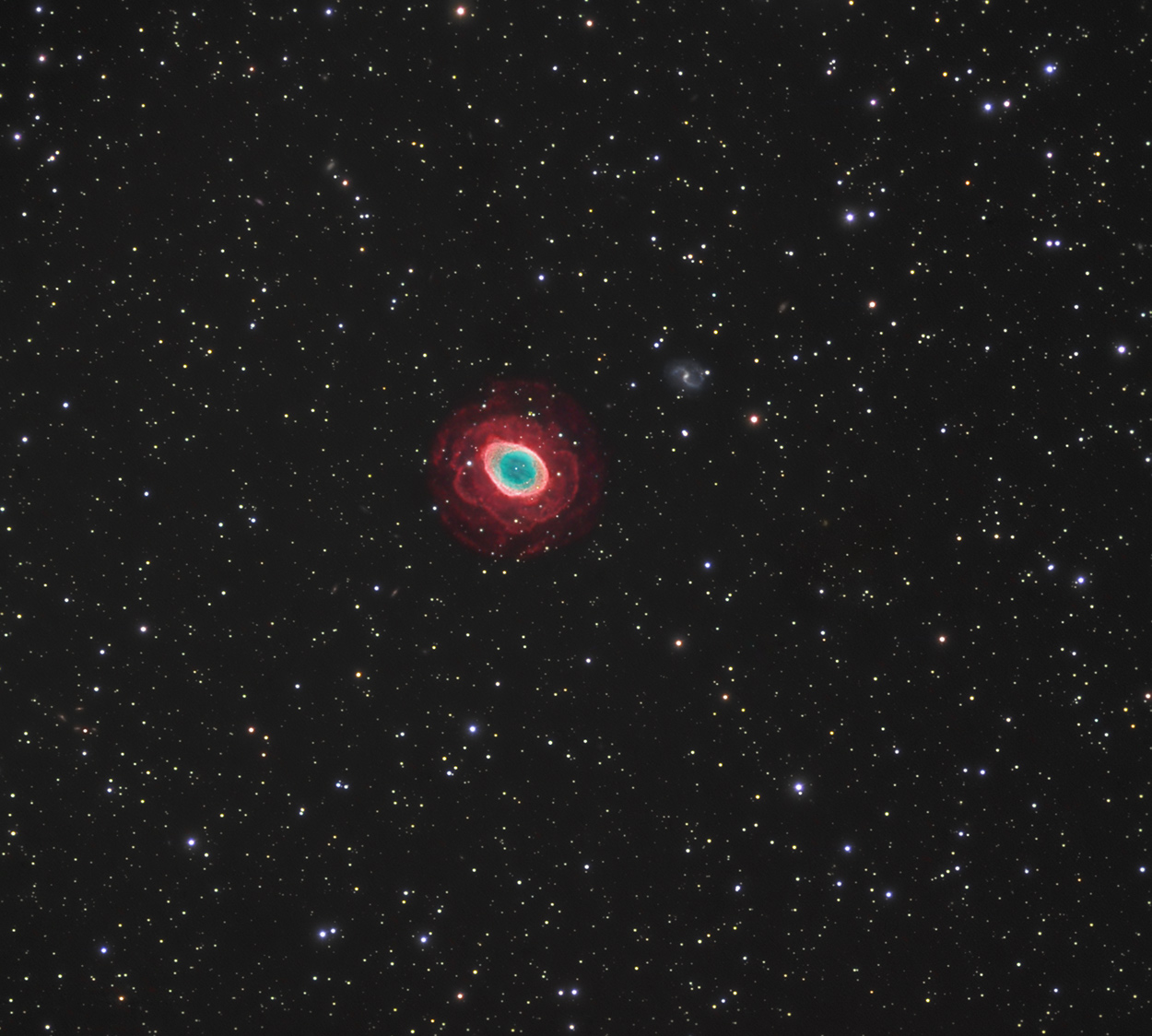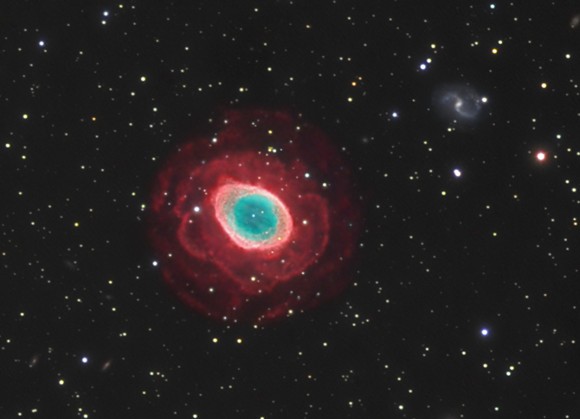For those of us old enough to remember riding on an old fashioned carousel, there was once a quaint custom where the operator would hold a brass ring out and the lucky contestant who captured it could ride again for free. Before you dismiss this astrophotograph as just another colorful look at a Messier, perhaps you better step inside the workings of the merry-go-round to learn more about what you’re really seeing here… Because this ring is pure gold.
Discovered by Antoine Darquier de Pellepoix in January of 1779 and independently discovered and cataloged by Charles Messier just a few days later, the famous comet hunter himself described it as being “a dull nebula, but perfectly outlined; as large as Jupiter and looks like a fading planet.” Perhaps it was that very description which coaxed Uranus’ discoverer – Sir William Herschel – to have a look for himself and class such objects as “planetary nebula“. Fortunately, Herschel’s telescope resolved M57 to a far greater degree and his descriptions were “a perforated ring of stars… none seems to belong to it.” Since that time, astronomers have been turning an eye towards this “curiosity of the heavens” in a great effort to not only understand its cause – but to capture it as well.
In 1800, German astronomer Friedrich von Hahn was the first to resolve out the Ring’s central star – a planet-sized white dwarf variable star which has an average magnitude of 15. At one point in its Mira-like life, it began shedding its outer layers in what we now believe to be a cylindrical shape and what we see is the bright torus of light from our point of view. Of course, none of this is particularly new news about the 2,300 light year distant M57. Nor is the knowledge when we are looking down this tunnel of expelled gas that we are seeing a decreasing ionization level as the distance from the central star increases. For all who have seen the Ring with their own eyes the innermost region appears dark – the result of only ultra-violet radiation. What we can capture visually is the inner ring, glowing brightly with the greenish forbidden light of doubly ionized oxygen and nitrogen. Where the true prize lay is much like a carousel – it’s just outside where only the red light of hydrogen can be excited.
In 1935 an astronomer named J.C. Duncan discovered something a bit more about the Ring than we knew – an extended halo of material which is all the remains of the star’s earlier stellar winds. It took the power of the Hubble telescope to resolve out dust filaments and globules, but now I invite you to take a closer look at which took 40,000 years in the making and spans 500 times the size of our own solar system.
It took Dr. Dietmar Hager a full month of work to compile some 12 hours of exposure time to reveal what you see here, but the results from StarGazer Observatory are nothing less than amazing. Like the Hubble Telescope images of M57, this image reveals small clouds of dark dust which have flowed out from the central star and are captured in silhouette against the glowing walls of the planetary shell. According to what we know, “These small, dense dust clouds are too small to be seen with ground-based telescopes, but are easily revealed by Hubble.” What’s more, the outer filaments only recently came to public light as ” The Spitzer Space Telescope’s powerful infrared vision detected this material expelled from the withering star.”
Congratulations, Dr. Hager. You have managed with a 9″ Earth-based refractor to capture for us what took two space telescopes to first reveal – along with a distant background galaxy in the full sized image. At least in my book, that means you’ve done far more than just reach for the brass ring…
You’ve captured pure gold.



WOW!
Also note in the image the presence of dark dust obscuration areas around the Ring. This phenomena was pointed out to me at the eyepiece when observing with friends Stephen O’Meara and Brent Archinal.
Truly a stunning image. It never ceases to amaze me what talented amateurs with modern equipment can do these days. Next we’ll be seeing amateur Ultra Deep Fields or something!
A great article, Tammy! I would love to see more articles that pertain to observational astronomy.
Doing amateur deep field astrophotogrpahy really isn’t that hard or expensive any more. There is plenty of telescopes, cameras, mounts, books and people who can show you how it do it. All you need is the passion and the will to do it.
Thank you, marcellus! Promise me the next time you look through a telescope at M57 that you’ll look around for those envelopes of darkness? I was always so concerned about picking braiding out of the structure, or resolving the central that I never noticed them. It took two very good friends to point out I was missing something… and now I pass it on to you, my friend!
Tom? There really are fairly inexpensive astro-imaging telescopes and camera and I thank you for encouraging others.
Dr. Deits has proved that a 9″ refractor telescope can give the performance of some of these huge “light bucket” telescopes – thus dispelling a commonly held misconception that bigger is always better.
The amount of hours and love these fellows at MRO / AORIAI put into these images to share with others is deeply appreciated!
intresting article!
Fantastic image of one of my favorite views. Also, over the few years I have been able to view with a friend and start really learnining to use the eye at the eyepiece we seem to have even noted changes in the shape of the “Ring”. In 10 years or less it seems we are seeing more expansion and thinning of the edges. It seems more elongated and less distinct. We look at it often while we are out , and that is about as often as the sky will allow!
hello friends of the celestial wonders,
first off let me thank you Tammy for this great distinction, chosing one of my images for an article in UT.
as this is the second story around one of my images, I do have high hopes, this is gonna become a sort of “tradition”… 🙂
secondly,
thanks everyone for the nice comments, which I do appreciate very much!
light buckett or not…
well, it is a matter of what we want.
deep field or high resolved images.
deep field will always be the domain of super fast astrographs (f/3 – or even faster) and yet provide its operator with a huge flat field of view.
but in high resolved deep sky imaging, I think a non obstructed apo-optics is better:
it is a commonly held “biased thought” – or even a prejudice” in many “astro-imaging-brains” that a huge light buckett in terms of – let’s say 14 or 16″ RC – is mandatory when it comes to high resolved deep sky imaginng.
IMHO it is not!
this policy of deep sky imaging origins back in those days, when unobstructed apochromatic optics were simply not availabe,…at least not for us amateurs.
now they are! and as you see – hopefully – 9″ of such an apochromatic refractor are more than suffice to reach out for faint details in deep sky objects such as nebulae and galaxies.
9″es are capable of imaging at a high resolved level way below 1 arc second; a decent focal length granted, of course!
and most of the time, at least at my observatorie’s place, seeing is less well than 1 arc second…
certainly these 9″es need to be of perfect shape in terms of optical quality.
apochromatic optics in refractors do have 2 major advantages which a mirror-scope does not have:
– the contrast power is at maximum – no mirror scope can catch up (except for a “schief-spiegler maybe…)
– there are no spike-artefacts!
these spike artefacts that are typical for mirror scopes come from the spider-like construction that holds the secondary mirror.
around bright stars, these spikes are very well visible. many people tend to forget that these artefacts are also affecting faint and tiny details, and therefore also have an impact on the image created by such an optics. the spikes are cast around the tiny details as well, certainly, and these very details might get hurt…
a perfect apo does not suffer from that.
this is just a couple explanations, why a 9″ apo can easily equal a 16″ RC in resolving-power…
is this too much of provocation? I do not intend to provoke at all. it is a fact.
but in amateur astro-photography, it does not make a significant difference in terms of resolution of details, if you use a 16″ RC or a 9″ apo. seeing will mostly never provide you with conditions, that let you tak all advantage of the theoretical higher resolution power of a larger optics! we are limited to earth’s athmosphere.
certainly the big advantage of huge light bucketts is you can operate these systems at very fast focal length and yet gain a huge flat field of view,…but the price for this is the contrast, which we do need.
also larger mirrors can more easily operate at higher focal length: 20” f/8 results in 4m FL. if I want to operate my system at 4m (which I do!) I have to use a high quality barlow lens, and focal ratio goes down,…to f/18; making my system very slow…but thanks to sensitive CCDs, it is possible!
so, inferring from my personal experience , and also many of my apo-collegues have showed as well, purchasing a huge apo is not only an alternative to a big mirror scope – it is the very best choice in the first place!
be well,
Dietmar Hager
F.R.A.S.
http://www.stargazer-observatory.com
By the way, the prominent spiral to the upper right of M 57 is IC 1296. Also, notice several faint, anonymous galaxies also visible in the field. Congrats to Dr Hager not only for the ultra-deep exposures obtained for this color composite but also his apparent skill in processing these images to produce this thrilling image. I’ve been a longtime fan of your astroimages. Keep up the good work.
http://www.universetoday.com/wp-content/uploads/2008/06/m57-crop.jpg are those faint galaxies near M57?
last night as i was sitting outside looking at the sky as i do every night the smoke i blew out ( as i was thinking of my dearly departed mother) turned into a 9″ perfect diameter red velvet inner ring with a gold, brightest gold outer ring . It happened seven times in a row, all of them seemingly going up so high and disapearing what seemed like ten miles up, i ran inside woke my wife came back down, blew smoke and it was just smoke, my mind is in tact and i know what i saw. Was this a gas in the air thing or a sign. the wind was blowing side to side but these rings were clear and apeared six feet from my face and rose to the heavens , please contact me at graniteworldutah @hotmail if you can explain this, thank you, walter